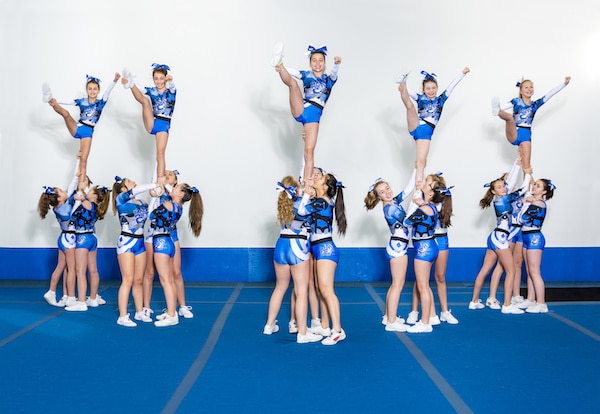March is National Cheerleading Safety Month
National Cheerleading Safety Month occurs in March, which creates awareness for programs designed to prevent injury during practice and competitions. It is also a time for coaches and parents alike to develop an emergency plan of action in the event of an injury.

Common Injuries
Injuries sustained from cheerleading can be classified as chronic or impact/trauma.
- Chronic injury. These injuries develop slowly and are due to joint/muscle overuse. Symptoms for chronic injuries include joint pain, muscle pain and inflammation of the affected area. Ignoring symptoms can cause the injury to worsen and result in a more serious injury.
- Trauma injury. Also known as an “impact injury”, physical trauma happens from damages to the body from an external force like falls, hits, blunt force or accidents. Tissue damage, internal injuries, and broken bones are examples of trauma or impact injuries, which often require immediate emergency care.
Safety Tips
Preparation is the best way to prevent injury before cheerleading season even begins. Knowing key safety guidelines helps coaches and parents know what to do in the event of an emergency.
- Certification. Parents, coaches or any team supervisor should make sure that they are CPR certified. CPR is an important first response action that almost anyone can learn. Additionally, both the Red Cross and the National Federation of State High School Associations (NFHS) offer Sports First Aid courses. These courses are accessible to anyone and can make a big difference in the event of an injury.
- Training. Cheerleading requires a lot of physical stunts, acrobatics, and cheers. Practice is important for both cheerleaders and their coaches as it trains them to function as one unit. This helps prevent accidents or missteps in routines which causes injuries.
- Action Plan. Quite possibly the most important safety tip for coaches and parents is for everyone to have a cohesive action plan as a precautionary measure. When a sudden injury occurs, everyone should be on the same page as to how they will respond.
Emergency Procedures
No matter how careful coaches are with their cheerleading squads, accidents do happen. It is important for them to know what to do in case of a sudden injury.
- Supervise the injured. An injured cheerleader should be accompanied by a coach during the entire duration of the emergency. Coaches will supervise and attend to the athlete. Once proper medical supervision is in place, the coach will provide a first-hand account of what happened.
- Medical information. This includes all necessary general contact information and other forms. These forms should also provide a medical history, allergies and anything else that may help medical professionals quickly perform the proper medical procedure.
Emergency Situations
Though some accidents or injuries may not require urgent care, it is still important to recognize an emergency situation when it occurs.
- Breathing difficulty. Having shortness of breath and other breathing difficulties are signs of a more serious condition. This can be due to an asthma attack, heart problems, physical injury to the chest or several other issues that require emergency assistance.
- Fainting. Dizziness and weakness can lead to fainting. In outdoor summer sports, these are symptoms of heat stroke or dehydration, which can be fatal if left untreated.
- Confusion. Concussions are accompanied by confusion. When there is an impact injury to the head, coaches and parents should look out for confusion or changes in mental status.
- Sudden and severe pain. This can be an indicator of a bone fracture, which will require an emergency visit and X-Ray to diagnose.
- Internal bleeding. If an injured cheerleader begins coughing or vomiting blood, there may be severe damage to the vital organs, requiring Emergency medical attention. Excessive external bleeding will also require immediate treatment.
The Emergency Center Treats Sports-Related Injuries
Cheerleading plays an important role in sports. It boosts self-esteem, team spirit and determination to win. By keeping everyone as safe as possible, coaches and parents alike can feel more at ease when cheering on their loved ones. When injuries occur, being proactive by getting fast treatment will help keep cheerleaders healthy and able to perform, compete and enjoy their favorite sport.
If injuries occur during cheerleading practice or a competition, do not hesitate to come to The Emergency Center right away. The Emergency Center provides up to 23 hours of Observation and offers 24/7 care with NO WAITING. Visit The Emergency Center’s convenient 24-hour location in San Antonio.

The Emergency Center
San Antonio
11320 Alamo Ranch Pkwy
San Antonio, TX 78253
Phone: 210-485-3644
Conroe
4019 I-45 N,
Conroe, Texas 77304
Phone: 936-247-9457
